It seems that when a brilliant idea comes a long it quickly becomes emulated by others thereby starting an obvious trend. Or perhaps lately the conversion, restoration, modification, or refurbishing of buses is like “the yellow sports car effect.” For weeks you keep seeing red sports cars. You can hardly stand it. By circumstance you are shopping for a new car and when it comes time to purchase you decisively choose the yellow model because the red model is everywhere you look. As you leave the dealership you have to wait for an oncoming car. Turns out the oncoming car is the yellow model just like you purchased. You are dumbfounded but quickly realize that perhaps the yellow model was all around you before. You just never could quite obsessing over the red long enough to see the yellow. Right now the red sports car is the restored bus and it is a mild obsession of the tiny house world.
Winkelman Architecture is known for being stylistically diverse while creating unconventional yet highly functional designs for their clients. Whether a New England home, a bark-on-log structure, a post and beam, or a boathouse, their portfolio varies widely from the substantial to the modest. They are also committed to the integration of renewable energy sources and the use of sustainable materials. So when Will Winkelman – a Tennessee born architect of 29 years – was approached by clients and challenged to Comprehensive restoration of a 1959 Chevrolet Viking short bus, he must certainly have been up for the challenge.
Turns out the client was looking for more than just a shiny, like-new bus. The client was looking for maximum flexibility: transportation for group outings, a camper for his family, and the ability to use it as a guest bedroom.
Originally designed to safely transport 12 passengers and a driver on the road, the skoolie converts to guest quarters for two as two single beds or joined in the center for queen accommodations.
As the Winkelman Architecture website shows the bus conversion initially began as a sketch on paper outlining what visually could be accomplished.
From the earlier photo it is easy to see that the bus was in an unspeakable condition and that a frame-off restoration would be needed. Turns out almost the entire bus had to be rebuilt in order to bring to life the “funky, hippy, Moroccan vibe” Winkelman’s client had in mind for the project. The mechanical aspects needed to be reworked. The body needed new parts and replacement parts had to be fabricated. This sort of attention to detail and integrity is evident in touches such as the multi-colored beads, tassel lamps, and Moroccan prints and fibers.
The interior has a beautiful, warm glow to it which is as much a natural part of the quarter-sawn white oak as anything else. The millwork gives that late-1960s “dad’s den” vibe without being too kitschy. The floor however is of durable, salvaged heart pine, installed with the original surface of the resawn boards up giving off the weathered, aged look the original floor had give way to through the years.
The finished skoolie comes complete with plumbing and electricity all gift-wrapped in a sort of mint green meets faded Army green. A nights stay is a present any one would want to open immediately.
Your Turn!
- Is a skoolie conversion too small to even camp in?
- Should restoration projects be returned to their factory coloring?






I used to have a 1970 something short Ford school bus that I converted into living space. The outside was left yellow but the inside was painted a light sky blue. It had a bed, kitchen counter, airtight (aka “tin can”) wood stove, crochet lace curtains but no bathroom. That thing went up above the Arctic Circle when I moved to Inuvik, NWT, embarrassing me and inconveniencing the crew when it died on the Peel River ferry. They were kind enough to charge my battery as I went back and forth 3 times before it would start the bus. I once drove it up to a camp job on a road that was partly creek and it served as camp kitchen when it proved to be better equipped than the official one. Once it died on the Alaska Highway so we pulled off to the side of the of the road where my then husband built a tripod out of logs, removed the engine and hitchhiked off with the old one, returned with a new one and plopped it in. Only took a week for the whole procedure.
Eventually it drove me crazy with mechanical issues so I sold it to someone else who drove it to Mexico and eventually back again with not even a flat tire. Overall I think I prefer something that doesn’t have an engine it.
Reminds me a bit of the tough little trucks in that 1970s movie “Sorcerer” with Roy Scheider where they have to transport nitroglycerine through the jungle. Great movie loosely based on the French “Film Wages of Fear”.
https://en.wikipedia.org/wiki/Sorcerer_(film)